
The Platinum Arowana is banned in the U.S.
©Nantawat Chotsuwan/Shutterstock.com
Have you ever heard of the Asian arowana? This beautiful fish is native to Southeast Asia and can fetch a pretty penny on the open market – we’re talking upwards of $430,000! It’s an incredibly valuable fish, especially in Asian cultures. Unfortunately, the Asian arowana is the $430k fish that isn’t allowed in the US.
Due to the high value of this fish, there is a thriving black market trade for Asian arowanas. Unfortunately, this black market results in far too many Asian arowanas smuggled into the United States, often in poor condition and without the proper paperwork.
Keep reading to discover more about Asian arowanas, why they’re so valuable, how to care for them, and if it’s legal to have these fish where you live.
What is the Asian Arowana?
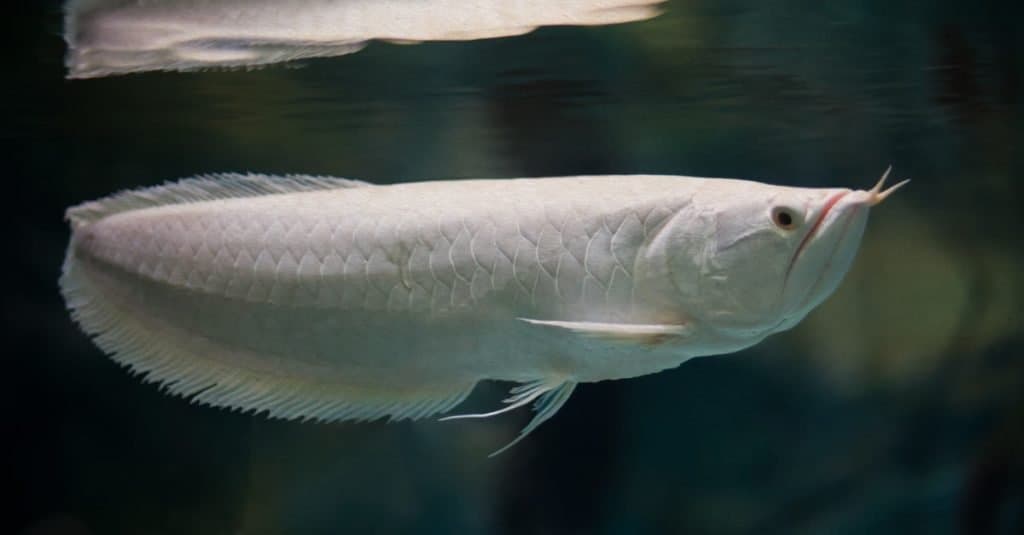
The Platinum arowana is one of the 10 most expensive fish in the world.
©Besjunior/Shutterstock.com
The Asian arowana is one of the top 10 most expensive fish worldwide. It’s a tropical fish that is native to Southeast Asia. Part of the Osteoglossidae family of fish, the Asian arowana has adapted to freshwater life and would not survive living in the sea. Also called a Dragon Fish due to its long body and scales resembling a dragon’s, another common name for the Asian arowana fish is Asian Bonytongue.
Asian arowanas are popular aquarium fish and can grow over three feet (90 cm) long! They come in several colors: green, red, gold, and platinum. The Platinum arowana has striking silvery scales and is in high demand among fish collectors.
The Asian arowana is considered a lucky fish in many cultures and a gift for special occasions. People believe Asian arowanas have mystical powers in some parts of Asia.
Why Are Asian Arowanas Banned in the United States?
The United States banned Asian arowanas because they are an endangered species. The International Union for Conservation of Nature (IUCN) classifies Asian arowanas as “Critically Endangered.” This classification means that they are at a very high risk of becoming extinct in the wild.
There are several reasons why Asian arowana populations have declined so dramatically. Deforestation is one of the biggest threats to these fish because it destroys Asian arowana habitats. Pollution and overfishing are also serious problems for this and other animals in Indonesia.
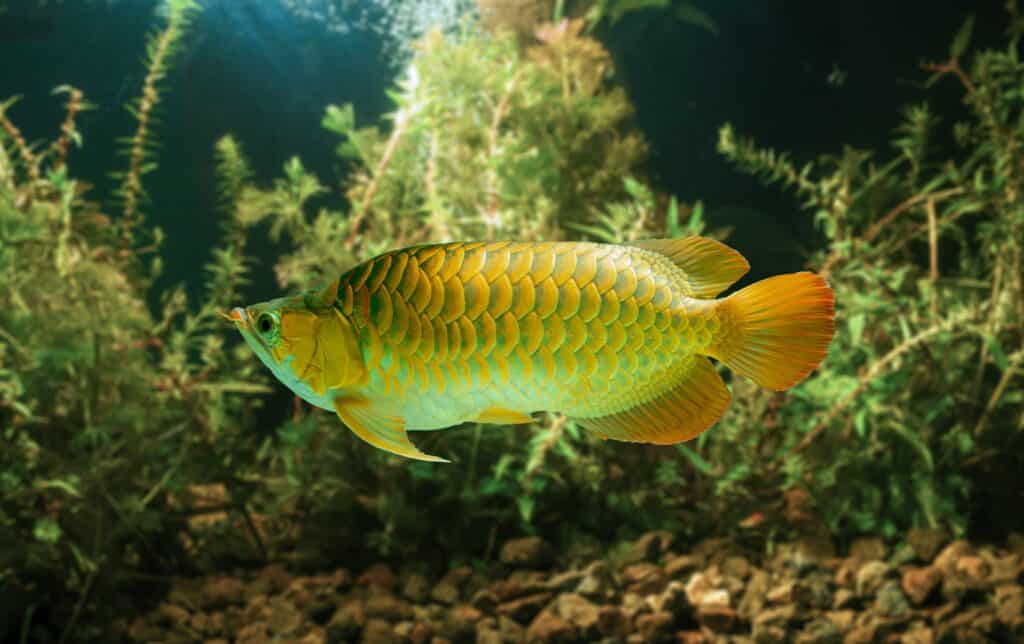
Gold-red Asian arowana in an aquarium.
©koifish/Shutterstock.com
In many parts of Southeast Asia, Asian arowanas are considered a delicacy. As a result, they are often caught and sold for food, further threatening wild populations.
The Asian arowana is also in demand as a pet. As these fish become rarer, their value on the black market increases. Due to the thriving black market, many illegal Asian arowanas enter the United States, often in poor condition and without the proper paperwork.
Because of their endangered status and the potential for illegal smuggling, the US Fish and Wildlife Service banned imports of Asian arowanas in 1975. As the Endangered Species Act specifies, it is currently illegal to buy, sell, or transport Asian arowanas in the United States.
Why is the Asian Arowana so valuable?
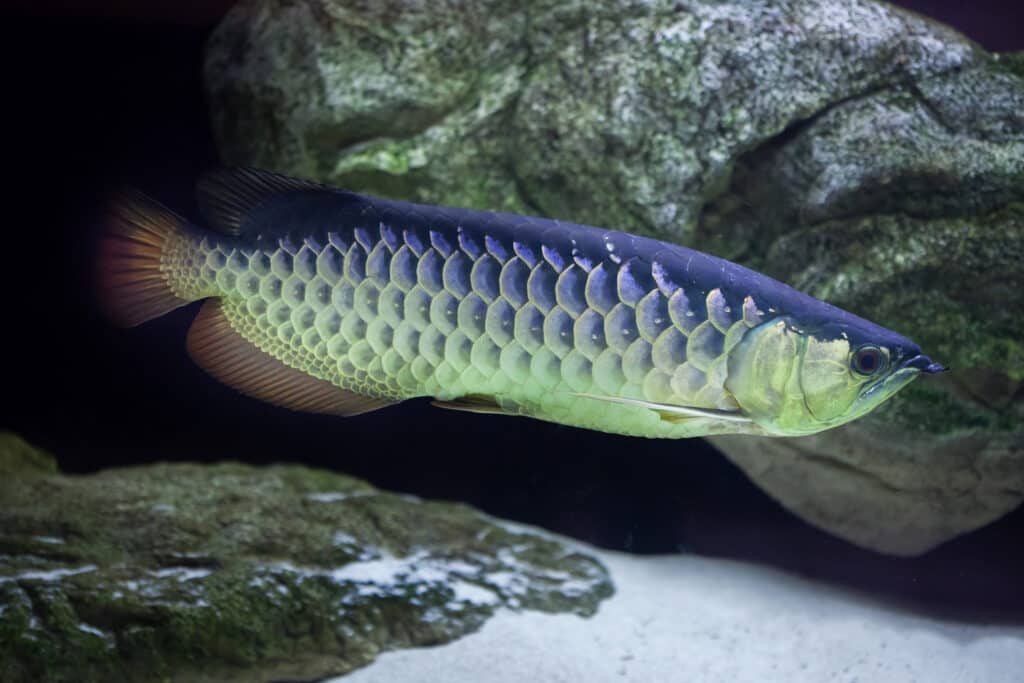
In 1975, 183 countries agreed to sign a treaty that banned the international trade of Asian arowanas.
©iStock.com/wrangel
The Asian arowana is a highly prized fish in the aquarium trade, fetching prices as high as $430k because of its beauty, folklore, and endangered status. Because they are pretty good luck charms that are hard to come by, their value seems to increase by the day.
Because they are so rare and valuable, owning an Asian arowana has become a status symbol among elite fish collectors. Unfortunately, as more people desire this status symbol, the black market sales of Asian arowanas increase.
Would you ever spend $430k for a fish? If so, read about where you could legally buy and own an Asian arowana.
Where are Asian Arowanas Sold Legally?
There are currently far more countries banning sales and imports of the Asian arowana than countries are allowing them. In 1975, 183 countries agreed to sign a treaty that banned the international trade of Asian arowanas.
Your best bet for finding legal breeders and sellers of Asian arowanas is Thailand, Indonesia, and Malaysia. Look for registered breeders with stellar reputations before purchasing any endangered fish.
Asian Arowanas in Feng Shui
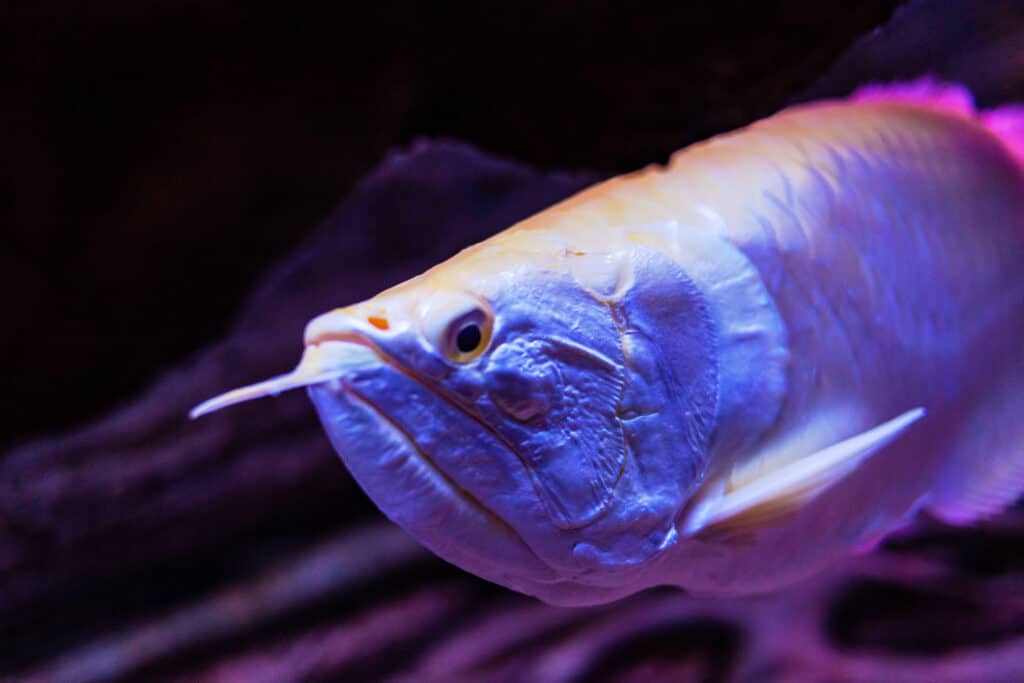
Some believe the Asian arowana brings good health and fortune to their homes.
©iStock.com/KeongDaGreat
Asian arowanas are good luck symbols in many cultures, particularly in the practice of Feng Shui. In addition, these remarkable fish represent power, strength, and prosperity. Some people believe Asian arowanas bring good health and fortune to their homes. Those cultural beliefs help explain the Asian arowana’s enormous price tag of $430k!
Because of these beliefs, Asian arowanas are often kept as pets or displayed in homes and businesses as a way to attract good luck.
The Black Market Trade for Asian Arowanas
Asian arowanas are some of the most sought-after fish in the world. Thus, the black market for these beautiful fish is thriving and threatening to wipe out Asian arowana populations worldwide.
But black market sales of the Asian arowana come with high stakes in the United States. If caught, people could face getting years of jail time and thousands of dollars or more in fines.
If you’re thinking of getting one of these fish, be aware of the risks involved—you could waste a lot of money or, even worse, spend time in prison.
Tips for purchasing an Asian Arowana

Young Asian arowanas are fine in a 60-gallon tank but quickly grow out of them.
©iStock.com/TatianaMironenko
Buying an Asian arowana can be problematic, and these fish cannot be legally purchased in the United States and many other countries. However, if you live in an area where breeding and raising these fish in captivity are allowed, here are some options for buying an Asian arowana of your own.
One option is to find a breeder or dealer willing to ship the fish to you. Look for online forums or search for reputable dealers in your area. However, we can’t stress enough to check and double-check the reputation of the dealers you work with. Because Asian arowanas are so rare and prized, many scammers are trying to make millions off unsuspecting collectors in shady ways.
Another option is to travel to a country where Asian arowanas are legally purchased. This option can be tricky, as you will need to make sure that you are following all of the necessary import/export regulations. In addition, once you have your fish, you will need to arrange for proper housing and care.

These fish cannot be legally purchased in the United States.
©Kiettisak8/Shutterstock.com
How to Care for an Asian Arowana
The Asian arowana is a majestic creature that can grow up to three feet long. If you’re thinking of adding one of these beautiful fish to your home aquarium, there are some important things to know first.
Asian arowanas originate from Southeast Asia and can be found in slow-moving waters found in wetlands, forested swamps, and blackwater rivers. They prefer warm water, so you’ll need to maintain a water temperature of 75-85 degrees Fahrenheit (24-29 degrees Celsius) in your aquarium.
Because these fish grow so big, you’ll want to provide your Asian arowanas with plenty of space in their tank. Your young Asian arowana is fine in a 60-gallon tank, but they will quickly grow out of it. For adult Asian arowana, invest in a 250-gallon tank to accommodate their size at full maturity.
When it comes to tank mates, Asian arowanas can be aggressive, so it’s best to keep them alone or with other large fish that can hold their own.
Check out this handy pet fish guide for more fish care tips! Your Asian arowana can thrive in your home aquarium for many years with proper care.
What Is the Life Expectancy of an Asian Arowana?

Arowanas eat many foods in captivity, including pellets, live or frozen fish, krill, worms, shrimp, crickets, and other insects.
©iStock.com/Vitalij Sova
In the wild, Asian arowanas can live for 20 years or more! In captivity, they can live even longer if they are well-cared for. When considering caring for an animal that lives this long, keep that in mind. Do you have enough time, support, and means to care for a fish for that many years?
How much are you willing to invest throughout its long life to protect your rare fish from being stolen? Unfortunately, this valuable aquarium fish is at constant risk of being taken, plus causes concern for your safety.
What Do Asian Arowanas Eat?
Asian arowanas are native to South and Southeast Asia, and their diet consists mainly of small fish, crustaceans, and insects. They eat reptiles and mammals on occasion in the wild. Asian arowanas eat many foods in captivity, including pellets, live or frozen fish, krill, worms, shrimp, crickets, and other insects. Therefore, it is crucial to offer a variety of foods to ensure they get the nutrients they need.
How Often Should I Feed My Asian Arowana?
Fully mature adult Asian arowanas should eat 2-3 times per week, and juveniles should eat 3-4 times per week. It is vital to offer only as much food as they can eat in a few minutes. These fish are susceptible to obesity and other health problems if overfed. If you are unsure how much to feed your arowana, ask your veterinarian or a qualified aquarium technician for guidance.
How Do Asian Arowanas Reproduce?
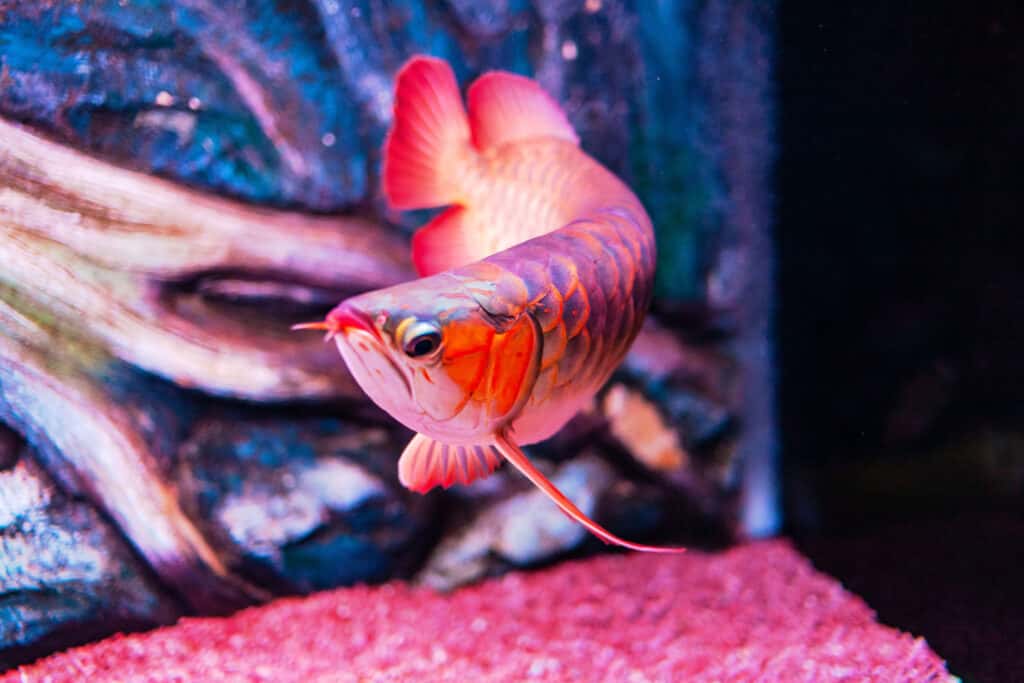
Baby Asian arowanas are born with a distinctive black stripe running down their bodies.
©iStock.com/KeongDaGreat
Asian arowanas are polygynous, meaning each male will mate with multiple females. The breeding season typically lasts from April to June; during this time, the males build nests out of plant material to entice females.
Once a female is ready to lay her eggs, she will enter the male’s nest and deposit them amongst the plants. The male Asian arowana fertilizes the eggs and protects them until they hatch. Next, male Asian arowanas hold the eggs in their mouth for about a month to incubate them. Incubating eggs this way is a practice called mouthbrooding.
Baby Asian arowanas are born with a distinctive black stripe running down their bodies, and this stripe will eventually fade as the fish grows older.
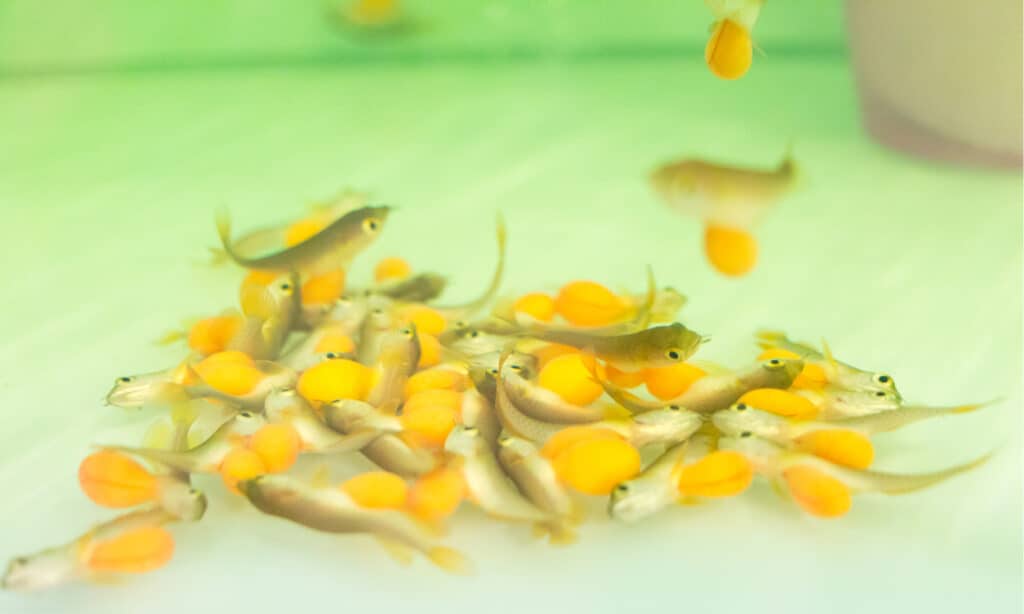
Baby Asian Arowana fish in an aquarium.
©kunanon/Shutterstock.com
During the first few months of life, baby Asian arowanas rely on their yolk sacs for nutrition. They will start to feed on small insects and other invertebrates once they have exhausted their yolk sacs.
As they grow older, Asian arowanas will continue to feed on various small animals, including insects, crustaceans, and even small mammals.
Which Types of Fish are Similar to the Asian Arowana?
A few different types of fish are similar to the Asian arowana, including the African arowana, the Australian arowana, and the South American arowana. These fish are members of the family Osteoglossidae, which contains only one other living species: the bony tongue fish.
The African arowana is the most similar to the Asian arowana in appearance and size. They are long and slender, with large scales and a long tail. African arowanas are native to the rivers of Africa, including the Nile River.
The Australian arowana is also similar in appearance to the Asian arowana, and Australian arowanas are native to Australia and New Guinea. The common name Australian arowana could refer to the Gulf Saratoga or Spotted Saratoga fish breeds.
The South American arowana (AKA Silver arowana) is the least similar in appearance to the Asian arowana. They are shorter and stockier, with smaller scales and shorter tails. South American arowanas are native to the rivers of South America, including the Amazon River.
When You Want the $430k Fish That Isn’t Allowed in the US
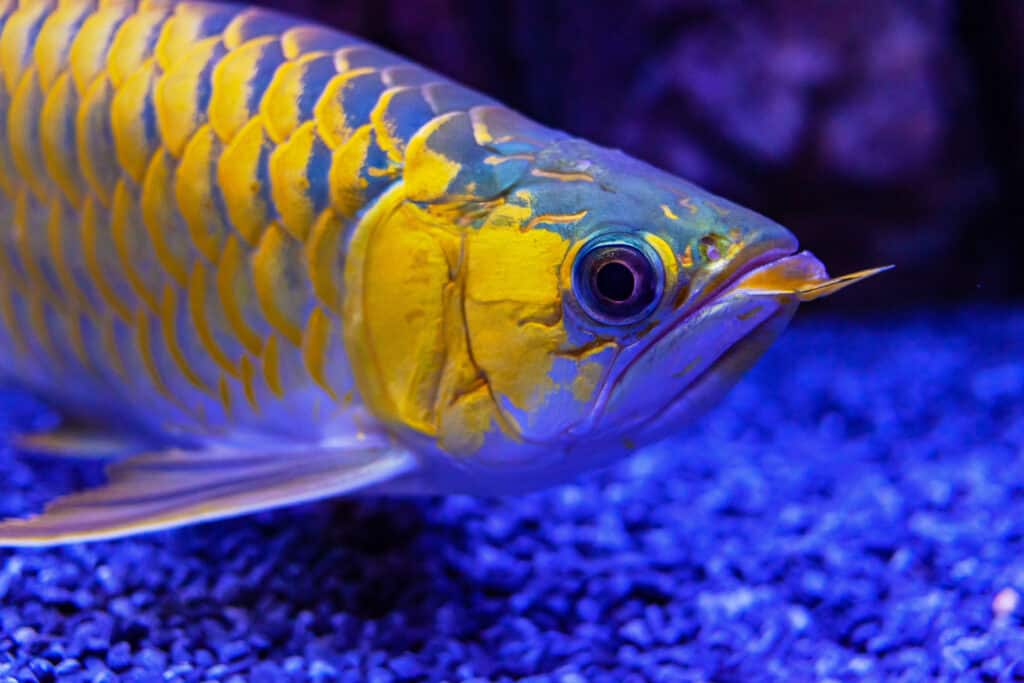
Male Asian arowanas hold the eggs in their mouth for about a month to incubate them.
©iStock.com/KeongDaGreat
Sorry, fish enthusiasts and caregivers in the US! While the Asian arowana is a beautiful and valuable fish worth up to $430k or more, you cannot own one in the United States. So enjoy them in photos and videos while filling your aquarium with legal fish instead. Or forget the fish and buy a luxury car for the same price.
Be aware of the risks for those of you determined to bring an Asian arowana home. Even if allowed to own one legally in your country, the popularity of these fish brings automatic security risks to you, your family, and your pet.
The photo featured at the top of this post is © iStock.com/KeongDaGreat
Thank you for reading! Have some feedback for us? Contact the AZ Animals editorial team.






